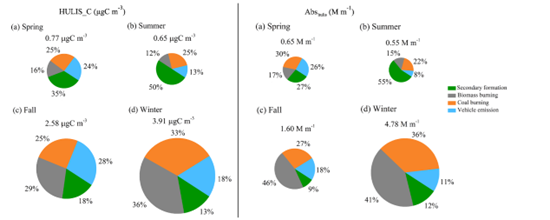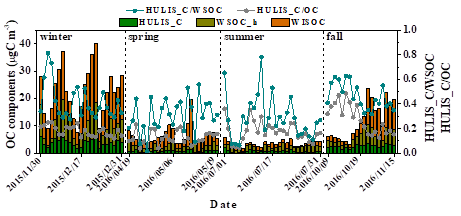Yuan, W., Huang, R. J.*, Yang, L., Ni, H., Wang, T., Cao, W., Duan, J., Guo, J., Huang, H., and Hoffmann, T.: Concentrations, optical properties and sources of humic-like substances (HULIS) in fine particulate matter in Xi'an, Northwest China, Sci. Total Environ., 789, 147902, 2021.
Humic-like substances (HULIS) are ubiquitous in the atmospheric environment, which affects both human health and climate. The chemical characteristics and sources of HULIS, however, are still not well understood.
A research group led by Prof. HUANG Rujin from the Institute of Earth Environment (IEE) of the Chinese Academy of Sciences studied the concentrations, optical properties and sources of HULIS in a one-year atmospheric fine particles in Xi’an.
Both mass concentration and absorption coefficient (Abs365) of HULIS show clear seasonal differences, with the highest average in winter (3.91 μgC m−3 and 4.78 M m−1, respectively) and the lowest in summer (0.65 μgC m−3 and 0.55 M m−1, respectively).
The sources of HULIS_C and light absorption of HULIS were analyzed by positive matrix factorization (PMF) and four major sources were resolved, including secondary formation, biomass burning, coal burning, and vehicle emission. Our results show that secondary formation (i.e., gas-to-particle conversion from e.g., photochemical oxidation) was the major contributor to both HULIS_C (50%) and light absorption (55%) of HULIS in summer, biomass burning and coal burning were
major sources of HULIS_C (~70%) and light absorption (~80%) of HULIS in winter.
It is worth noting that biomass burning and coal burning had higher contribution to HULIS light absorption (47% in spring, 37% in summer, 73% in fall, and 77% in winter) than their corresponding contribution to HULIS_C concentration (41% in spring, 37% in summer, 54% in fall, and 69% in winter). However, vehicle emission had lower contribution to HULIS light absorption (26% in spring, 8% in summer, 18% in fall, and 11% in winter) than to HULIS_C concentration (24% in spring, 13% in summer, 28% in fall, and 18% in winter).
This study, published in Science of the Total Environment, highlighted the important concentrations of biomass and coal burning to HULIS in atmospheric fine particles.
Fig.1 Temporal variation of OC fraction, i.e. HULIS_C (carbon content in HULIS), WSOC_h (hydrophilic water-soluble organic carbon), WISOC (water-insoluble organic carbon).![]()

![]()
Fig.2 Seasonal contribution of sources to concentration (left) and light absorption (right) of HULIS in Xi'an.


